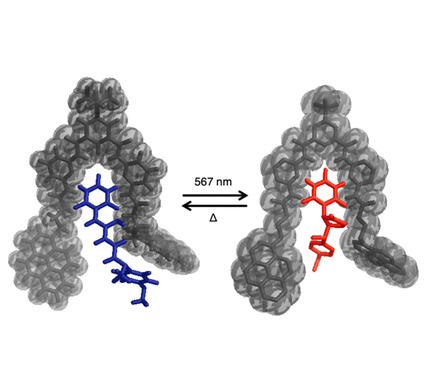当前位置:
X-MOL 学术
›
ChemPhotoChem
›
论文详情
Our official English website, www.x-mol.net, welcomes your
feedback! (Note: you will need to create a separate account there.)
Hydrogen‐Bonding Donor‐Acceptor Stenhouse Adducts
ChemPhotoChem ( IF 3.0 ) Pub Date : 2020-02-11 , DOI: 10.1002/cptc.201900295 Neil Mallo 1 , Arnaud Tron 2 , Joakim Andréasson 3 , Jason B. Harper 1 , Lorrie S. D. Jacob 1 , Nathan D. McClenaghan 2 , Gediminas Jonusauskas 2 , Jonathon E. Beves 1
ChemPhotoChem ( IF 3.0 ) Pub Date : 2020-02-11 , DOI: 10.1002/cptc.201900295 Neil Mallo 1 , Arnaud Tron 2 , Joakim Andréasson 3 , Jason B. Harper 1 , Lorrie S. D. Jacob 1 , Nathan D. McClenaghan 2 , Gediminas Jonusauskas 2 , Jonathon E. Beves 1
Affiliation

|
The binding of donor‐acceptor Stenhouse adducts (DASAs) bearing hydrogen‐bond recognition groups by Hamilton‐type receptors significantly influenced their photoswitching properties by altering thermal barriers to isomerization. The thermal barrier between the most stable linear isomer and the photogenerated isomer is lowered on binding to a receptor, and this barrier is crucial for switching properties. The thermal isomerization was shown to proceed via a stepwise linear‐enol‐keto mechanism in DMSO where the tautomerisation barrier is within 2 kJ ⋅ mol−1 of that of the rate‐determining step, which may be important for analyzing switching properties.
中文翻译:

氢键供体-受体模板加合物
带有氢键识别基团的供体-受体Stenhouse加合物(DASAs)与汉密尔顿型受体的结合,通过改变异构化的热障,极大地影响了其光开关性能。当与受体结合时,最稳定的线性异构体和光生异构体之间的热障降低,并且该热障对于转换性能至关重要。该热异构化被证明继续经由逐步直链烯醇-酮机构在DMSO其中互变异构屏障是在2千焦耳⋅摩尔-1的所述速率决定步骤,其可以是用于分析开关性质是重要的。
更新日期:2020-02-11
中文翻译:

氢键供体-受体模板加合物
带有氢键识别基团的供体-受体Stenhouse加合物(DASAs)与汉密尔顿型受体的结合,通过改变异构化的热障,极大地影响了其光开关性能。当与受体结合时,最稳定的线性异构体和光生异构体之间的热障降低,并且该热障对于转换性能至关重要。该热异构化被证明继续经由逐步直链烯醇-酮机构在DMSO其中互变异构屏障是在2千焦耳⋅摩尔-1的所述速率决定步骤,其可以是用于分析开关性质是重要的。











































 京公网安备 11010802027423号
京公网安备 11010802027423号